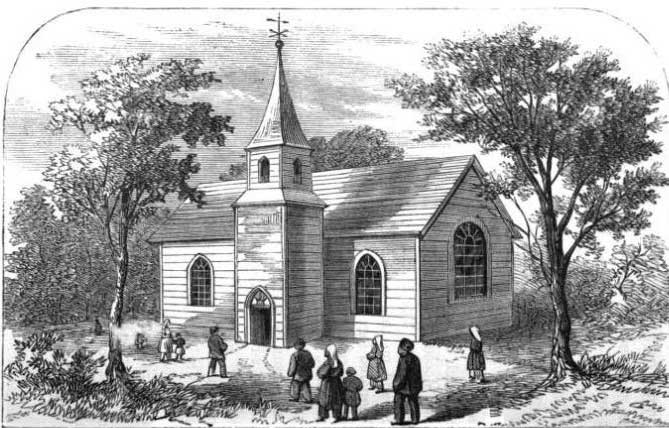

THIS substantially- built church was completed last summer, 1865, just before the Missionary, who had laboured for many years at Moose Factory, left for England. My little friends may judge how great was his joy at seeing one scaffold-pole after another taken down, and hearing the workmen say, "It is finished at last," before he was summoned to go, and commence his voyage to England. The church is very prettily situated on the bank of the Moose river, there a mile wide, which runs in front of it. The foundation of the structure is stone, and on this are placed, one over the other, well-squared logs of wood, which are fastened together by large iron bolts. The roof is composed of thick plank, covered with weather-boards, but the spire is covered with sheets of bright tin, which, when the sun is shining brightly, look almost like burnished silver. In the tower is a very good bell, which calls the people to service; and I think my young friends would be very glad to see the Indians wending their way to the house of God, with their prayer-books and hymn-books under their arms, and, entering with them, to hear them sing the praises of God with their sweet voices. Of course they would not understand the words used, although they could join in spirit as the Indians sang the morning hymn, the first verse of which says--
Ako koskose net achak,
Nanaskom Kechemuneto;
Kelepe maka wunishka
Kitche ayumechekayua.[164] Is it not delightful to know that, in a great many places, where formerly God was unknown, churches now stand, showing that heathenism is departing, and Christianity taking its place? and that many, who once were the willing slaves of Satan, are now soldiers and servants of the holy Jesus?
Both my young friends and older friends must exert themselves to the utmost, that more Missionaries may be sent from England; they must labour that the glad tidings may be more widely published, so that more churches may be required, in which may assemble those who have accepted the invitation, "Come unto Me, and be ye saved."
INTERIOR OF THE MOOSE CHURCH. IN the last "Instructor" I gave my young friends a representation of the church at Moose Factory where the Church Missionary Society has a very important station. Now I hope you all know where Moose Factory is. If not, please take your atlas, turn to the map of North America, where you will see a very large inland sea, called Hudson's Bay; look down to the south-west corner, and there you will discover the object of your search.
I must now take you inside the church, and show you the internal arrangements. You enter at the side, and directly in front of you stands a neat stone font, purchased by the people themselves: turning round, and looking towards the communion-table, you observe that there are two sets of tablets, one of which you can read, because they are in the English language, but the others you cannot, because they are in the Cree language, and a curious character is employed in writing them. I will give you a specimen: here, then, is the eighth commandment. Although you cannot read them, the Indians can very nicely. The Indian tablets were painted by the Missionary himself, and the pillars which support the communion-rail were turned in a lathe by himself; so my little friends should never consider any knowledge beneath them, as they do not know how useful it may be in after life, when, I hope, some among them may be Missionaries in lands where perhaps they will be obliged to depend a very great deal on themselves [179/180] not only in matters connected with their churches, but in many others besides. The table is covered with a neat crimson cloth, and, in fact, every thing about the church is neat and good. As yet we have no harmonium, but I hope to see even that there; then all will be complete.
The reason of the tablets being in both languages is this--two distinct congregations assemble in the church for divine service. At half-past six o'clock in the morning the bell is rung, and at seven a large number of Indians have taken their places, and service commences in their language. At half-past ten the bell is rung again to call the English-speaking portion of the community, about a hundred and twenty in number, to prayers. At two the bell is rung for the third time, to call the children to school, and again at three, for the Indians to assemble for evening service. What a privilege is the Christian Sabbath! how delightful the sound of the bell! how glorious the hymn of praise rising from a congregation of converted Indians, going with angels and archangels and all the host of heaven, in singing the praises of the Redeemer.